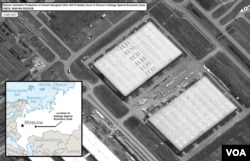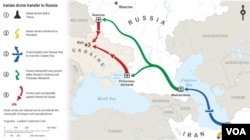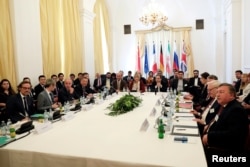Moscow has not only received hundreds of Iranian drones but is working with Iran to produce them from inside Russia, according to the White House -- a sign of the deepening military partnership between the two countries.
“We have information that Russia is receiving materials from Iran needed to build a UAV manufacturing plant inside Russia,” said National Security Council spokesperson John Kirby in a statement sent to VOA Thursday. “This plant could be fully operational early next year.”
The White House released satellite imagery of the planned location of the UAV (unmanned aerial vehicle) manufacturing plant in Russia’s Alabuga Special Economic Zone.
Kirby said that currently, drones are built in Iran, shipped across the Caspian Sea from Amirabad, Iran to Makhachkala, Russia, and then used operationally by Russian forces against Ukraine.
On Friday, the Biden Administration is releasing a new advisory to help businesses and other governments “better understand the risks posed by Iran’s UAV program and the illicit practices Iran uses to procure components for it.”
“This will help governments and businesses put in place measures to ensure they are not inadvertently contributing to Iran’s UAV program,” Kirby added.
Russia has increasingly deployed drones to bombard Ukrainian cities and targets in recent weeks. They are “a difficult target because Ukraine has limited air defense resources,” Ukrainian Air Force spokesperson Yurii Ihnat told VOA Friday.
“Iranian drones are hard to detect; they are slow,” he said. “The Shaheds fly very low, use the river delta and forest, and drop from the radars.”
Ihnat noted that Moscow sends the drones to all parts of Ukrainian territory from different directions. “Ukraine Air defense today is focused on the protection of big towns, infrastructure objects, and critical infrastructure,” he said.
JCPOA sunset
This latest revelation is part of the administration’s periodic release of intelligence findings about Russia’s war in Ukraine, with the goal of further isolating Moscow and its supporters.
The timing coincides with sunset clauses in the 2015 Iran nuclear agreement, known formally as the Joint Comprehensive Plan of Action (JCPOA), which imposed international restrictions on Iranian weapons.
Many of the JCPOA’s sunset clauses were already made obsolete after President Donald Trump withdrew the United States from the agreement in May 2018 and reimposed sanctions, which led Iran to breach its obligations and enrich uranium to higher levels beginning in July 2019.
Still, since the JCPOA was never officially nullified by its other signatories -- Iran, the European Union, Russia and China -- from a legal standpoint the sunset clauses matter.
In October 2023, the JCPOA bans on Iran’s import and export of missile-related technology will formally end, including on missiles and drones with a range of 300 kilometers (186 miles) or more.
In other words, in a few months it will be officially legal to trade Iranian missiles and drones.
The U.S. and partners want to alert businesses around the world about the Iran-Russia cooperation on drones and the drones’ devastating impact in the war in Ukraine, said Alex Vatanka, director of the Iran Program at the Middle East Institute. The goal is to interrupt the production of the drones, which depend on components available on world markets.
“The U.S. clearly wants to put businesses on notice in a preemptive move and to highlight the reputational risks,” he told VOA.
While the administration may try to disrupt the drones’ production chain, Vatanka is skeptical that Western political pressure will compel Iranian leaders to rethink their military cooperation with Moscow.
“Tehran has basically decided to put its money on Russia,” he said. “The calculation is as simple as it is cynical: By supporting Russia today in Ukraine, Iran can hope that Moscow will back Iran in its conflict with the U.S.”
Two-way support
As it purchases Iranian drones, mainly the Shahed-136, Russia has provided Iran with “unprecedented defense cooperation, including on missiles, electronics, and air defense,” Kirby said, adding that Tehran is seeking to purchase billions of dollars of additional Russian military equipment, including attack helicopters, radars, and YAK-130 combat trainer aircraft.
Earlier this year, Iran announced that it had finalized a deal to buy Russian Su-35 fighter jets.
“This is a full-scale defense partnership that is harmful to Ukraine, to Iran’s neighbors, and to the international community,” Kirby said, adding that the administration is working with allies and partners to hold Moscow and Tehran accountable, including through existing and additional sanctions and export restrictions.
Collaboration between Tehran and Moscow is likely to continue, said Michael O’Hanlon, senior fellow and director of research in Foreign Policy at the Brookings Institution.
He said the U.S. should be mindful of Moscow garnering support from other partners, namely Beijing.
“We should be careful not to so demonize China,” he told VOA. “In regard to the Ukraine conflict in particular as well as current geopolitics more generally, that we also drive Beijing and Moscow closer together under the principle that the enemy of my enemy is my friend.”
The Shahed drones, often called suicide or kamikaze drones, have an operational range of around 2,000 kilometers. Packed with explosives, they can be directed at targets and detonate upon impact like a missile.
They can also be launched in a swarm where several of them are launched at the same time in formation.
On Friday, the Russian military mistakenly identified one of its own drones as Ukrainian and took it down.
Myroslava Gongadze contributed to this report.








